Core drilling of wells: technology and nuances of work
One of the most productive and economical methods for forming mine workings is core drilling. It is used in mineral exploration and engineering geology.In addition, this is the easiest and fastest way to gain access to groundwater for organizing water supply.
You will learn everything about the specifics of core drilling, the tools necessary for its implementation and application features from our proposed article.
The content of the article:
Scope of application of core drilling
Core drilling is a method that makes it possible to determine with the greatest accuracy the depth of the roof and base of soil layers, as well as the depth level of the groundwater table.
Core drilling technology is widely used in the following industries:
- Water supply in industrial and private spheres. Drilling wells for private water supply, organizing water intake for entire villages or city blocks is effectively carried out by core drilling due to the fact that the drill easily penetrates to great depths. The core tool is capable of lifting almost any destroyed rock except for water-saturated and loose, non-cohesive soils (sand, gravel, pebbles);
- Geological exploration in the mining industry. When rock passes, a point effect on the ground occurs along the radius of rotation. In other words, with a projectile that is structurally reminiscent of a pipe, a solid mass of rocks is drilled out without disturbing their structure and condition.
- Construction. Conducting geotechnical research to study the physical and mechanical properties of soils and the condition of rocks. Core technology makes it possible to accurately identify ground water and take water samples to study their aggressiveness towards concrete.
During core drilling, a core is extracted - a column of soil or adjacent soil layers. The core is characterized by a solid natural structure, which ensures a comprehensive analysis of the studied rock. Drilling with a core pipe allows you to determine with the highest accuracy the depth of rock for study purposes.
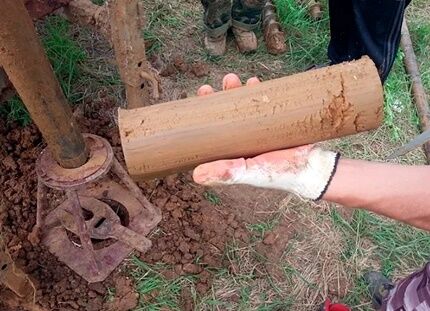
The use of a core drill in construction significantly facilitates and speeds up the processes. A pile is easily driven into the hole prepared with a core drill or a ready-made reinforced concrete structure is mounted. Core drilling allows you to create cylindrical holes in brick and concrete structures.
Work technology and equipment
There are two known methods of using a core drill: working with liquid supply to the bottom hole or working dry, that is, without drilling fluid.
Drilling without the use of drilling fluid is used if non-cohesive soils are saturated with natural moisture in sufficient quantities for penetration and extraction. Water is also not supplied to the excavation shaft when driving through fluid-plastic, soft-plastic and refractory loams/clays, hard and plastic sandy loams.
The liquid must be used when drilling rocky and semi-rocky rocks.In the absence of water, in this case, deepening occurs much more slowly. In addition, the probability of premature failure of the bit increases significantly, and therefore dry drilling is considered more expensive.
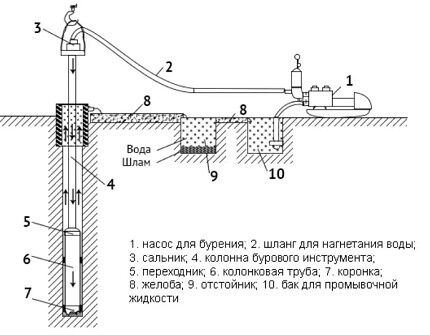
When drilling with drilling fluid, the rate of deepening increases significantly. Most often, this method is used when drilling wells of considerable depth. This allows the work to be completed in the shortest possible time with minimal risk of damage to the crown.
Water under high pressure is also supplied to the bottom during the development of a well in loose, non-cohesive soils, if core sampling is not an issue. In this case, the face is simply washed with a stream of water, freeing the mine shaft from the destroyed soil.
The principle of the core technique
The main element in core drilling is a destructive cutting part installed on the base of the core pipe. They call it a crown. For digging rocks, special crowns equipped with diamond cutters are used.
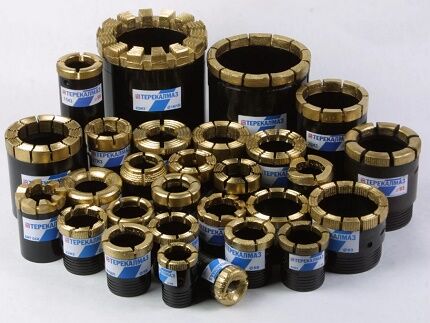
It is the diamond bit that ensures virtually unimpeded passage of the drill to great depths when driving water intake workings into limestone. That is, when developing wells buried in bedrock, in the cracks of which, as a result of centuries-old condensation, reserves of the purest underground water were formed.
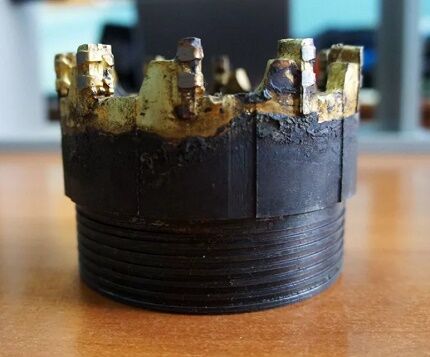
The rock is cut using a bit rotating at high speeds. The rotation speed of the drill can be adjusted depending on the density of the soil being developed. The crown “cuts” the soil only along the edge of a kind of cylinder, the central part of which is pressed into the core pipe.
To extract the core, the drill bit is raised to the surface. The soil captured by it is literally blown out of the core drill by a stream of air supplied to the upper part of the pipe. The blowing process is accelerated by tapping the projectile with a sledgehammer.
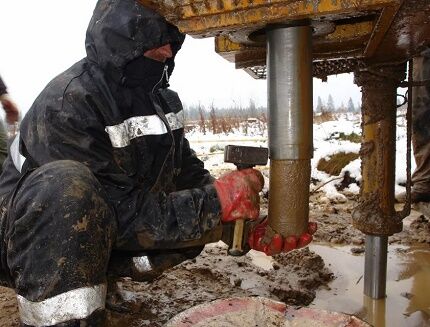
When passing through hard rocks, core drills have greater productivity than matrix and roller bits. This is due to the high rotation speed of the drill, which reduces the amount of development effort required.
In addition, the bits completely destroy the rock, which will need to be “scooped out” with a bailer or water must be supplied with pressure to wash the face. In fact, you will have to go through the same section twice, or even three times: first destroy it, then clear it. Core technology allows you to go through and clear the face in one go.
Machine tools and drilling rigs
The choice of machine or drilling rig is determined by the purpose of the well and its diameter. The popularity of the core drilling method determines the production of drilling rigs and machines all over the world. Heavy-duty tractors, trucks and all-terrain vehicles are suitable for rigs intended for exploration drilling.
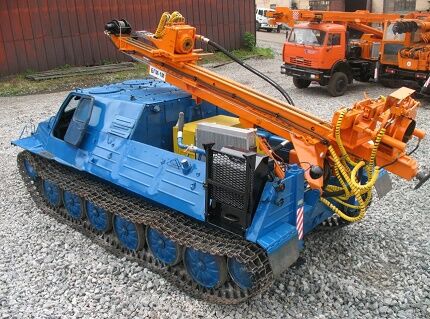
Most often, drilling equipment is mounted on classic cars of the MAZ, KAMAZ, and Ural brands. However, there are installation options for lighter equipment, which is used for drilling water wells in private construction.
At manual rotary drilling The core pipe is replaced by its historical predecessor - the glass. This projectile is a shortened version of a core tube with a pointed edge on the sole. The glass is screwed into the ground manually or using a motor drill and everything that is packed into it is removed to the surface.
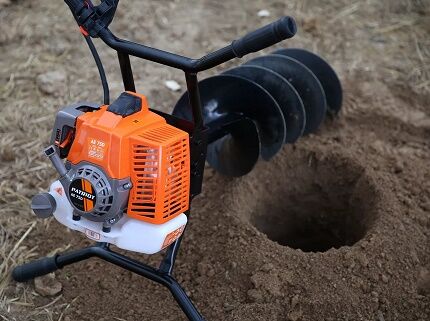
Equipment for drilling and arrangement of wells
When implementing core drilling, you need equipment that allows you to work at depth, develop and extract a wide variety of types of rocks. During work, periodic lifting of the material destroyed by the projectile to the surface must be ensured.
Standard set of drilling tools
To perform quality work you need:
- Core shells. They are used for both horizontal drilling and vertical excavation. Using standard core pipes, it is possible to drill at an angle of up to 45 degrees. Thin-walled core drills can be used exclusively for horizontal trenchless drilling when laying communications.
- Crowns. This is a rock-breaking tool that is fitted to a core tube to facilitate cutting out cores in rock. Brass bits are used for drilling sedimentary cohesive and non-cohesive soils. Carbide bits with diamond cutters are produced for drilling rocks and forming holes in concrete, asphalt, and brick walls.
- Steel casing pipes. Necessary for casing the excavation - forming a wellbore, carried out simultaneously with its deepening. Their diameter is equal to the diameter of the well. The casing for water intake is selected in advance, focusing on the diameter of the core pipe and the pump that is planned to be used in the well.
- Barbells. These are narrow pipes twisted together. Used to extend the drill string. Simply put, they are screwed alternately to the top of the core tube so that rotational motion can be transmitted to it at a depth greater than the height of the projectile. Height of core pipe + height of drill string = excavation depth.
- Translators. Necessary to ensure the joining of threaded connections of different diameters that are present on drill rods, rotators, flushing seals and other components.
- Flushing plugs and seals. With their help, it is possible to lift destroyed soil to the surface if there is no need to take a whole core. In this case, water is supplied to the face, washing the destroyed soil under pressure onto the day surface.
- Chisels. They are used to deepen the hole in the most difficult places for a core drill to penetrate. When using a bit, sometimes they switch from rotary drilling to cable-percussion drilling.
The presented tool is a standard set for drilling using core technology.In some cases, depending on the complexity of the development, additional tools and equipment may be required.

Features of the core pipe design
Design feature projectile during core drilling, it is due to maximum preservation of the integrity of the core and consists of a ring-shaped arrangement around a free passage. One of the most important characteristics is the coefficient core sampling It is defined as the ratio of the core diameter to the outer diameter of the tool.
The core drilling tool is standardized, differing mainly only in diameter. Based on structural characteristics, core pipes are classified into single and double. Single projectiles designed to operate in normal geological conditions are excellent for developing water wells.
A double tool with a non-rotating inner tube is used only in geological exploration. It is needed to extract rock samples that are easily destroyed under the influence of a variety of factors. It allows you to take a sample in its natural composition, with a natural percentage of minerals and waste rock.
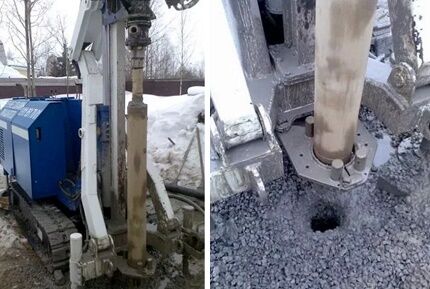
All core pipes are designed for the use of blowing, supplying drilling fluid to the bottom and cleaning the well. Their top is equipped with a technological hole through which water or a stream of air is injected.
Specifics of the cutting part of the projectile
Any crown is presented in the form of a ring with a thread on top, necessary for screwing to a core pipe, and cutters located on the lower end. Cutters can be solid cast or welded to this cutting metal part.
The following bits are used for core drilling:
- Carbide – fine-incisor, ribbed.
- Diamond – impregnated and small diamond.
Carbide cutting elements are designed for drilling “soft” soils. With their help, all types of clayey rocks of any consistency, semi-rocky rocks, low-moisture and wet sands of dense and medium density are drilled. To drill through sandstones and marls, crowns with tungsten-cobalt cutters are used.
Fine incisor bits are designed for drilling medium-hard rocks of small abrasiveness. They are equipped with octagonal or square cutters. When the cutters are positioned at different heights, a stepped face is also achieved, the advantages of which were outlined above.
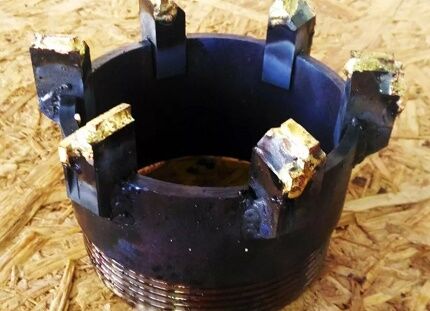
Ribbed bits are designed for drilling hard rocks of medium abrasiveness. The cutters of such crowns consist of steel cylindrical or prismatic headquarters with carbide insert. At the same time, even if the crown wears out, its performance does not decrease.
Crowns with diamond cutters are designed for drilling rocky and semi-rocky rocks of high abrasiveness.

The number of ribs is determined by the design of the crown and its diameter - there can be from three to six. Acceleration of the process of rock destruction can be achieved by shifting the ribs upward relative to the end of the crown. This ensures a stepped bottom hole and facilitates the passage of the washing fluid.
Well casing pipes
Both core and casing steel pipes are produced in accordance with GOST 51682-2000. In geological exploration and engineering geology, they are used to prevent the collapse of soil onto the face, which would not allow us to understand at what depth one geological layer is replaced by another.
IN arrangement of water intake workings casing pipes form the walls of the well. Another, production, pipe string is immersed into the casing assembled from them. Nowadays it is most often assembled from plastic. The production column is equipped with a filter to retain grains of sand and fine gravel during pumping.
The most common are casing pipes with nipple connections. In this case, the pipes have an internal thread on one side and an external thread on the opposite side. The excavation shaft is assembled from threaded pipes extremely simply and quickly.
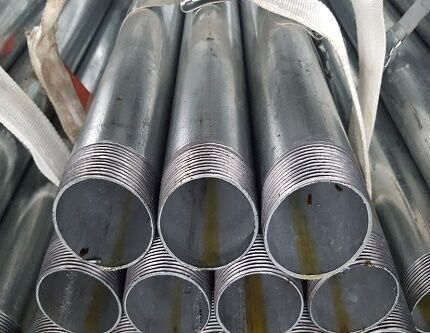
There are casing pipes designed for welded joints. They are not used in the private sector due to the labor-intensive column assembly process.
Both casing and core pipes are made of grade 45 steel with strength group “K”.To increase resistance to surface wear, the ends of the pipes are hardened. Depending on the drilling equipment used and diameter submersible pump in the construction of private water intake workings, pipes with a diameter of 100 to 200 mm are used.
Core drilling stages
Before starting work, you need to study the cadastral plan and prepare the working surface. It is necessary to ensure unimpeded access to the drilling site for both the drilling rig itself and the machine with the flushing fluid.
The next step is to dig a hole with a volume of at least 2 cubic meters - this will avoid the need to use an additional tank. The pit is designed to drain groundwater and used flushing liquid. To install the main part of the trunk, it is necessary to punch the soil.
Next, the selected bit is connected to the drill core pipe and selected casing pipes, which will increase as they deepen. The installation should be securely secured, after which the drilling rig is started.

As the core drill deepens and fills, it is periodically lifted to the surface and cleared of soil captured by the tool during drilling. After which the drill, freed from the core, can again be immersed in the hole of the well to continue drilling.
To lift to the top, the drill pipe string, consisting of a core tool and rods, is disassembled. That is, they sequentially separate the rod after the rod until the core pipe is removed from the barrel.
The best option for developing a well for private owners is considered to be core drilling, accompanied by flushing. In this case, no samples need to be taken. The main thing is to quickly form the barrel and clear it of sludge. At the same time, preparation of workings for upcoming use.
For washing, you can use any water; water from a nearby pond or river is quite suitable. Drilling can also be done dry if a well is being developed for sand. Usually in this case, a couple of buckets of water as a drilling fluid are enough just to cool the projectile at the bottom.
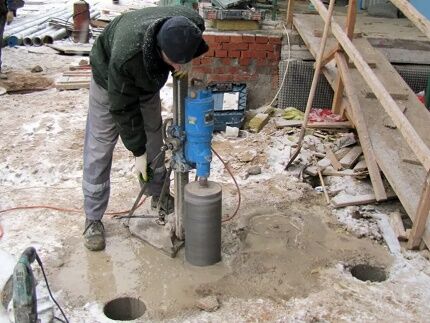
When working in loose, low-moisture sand, it is recommended to add liquid glass or clay mass to the working solution to strengthen the walls of the hole. In any case, when a drill passes through a horizon with an unstable structure, it would be justified to strengthen the walls of the well with casing pipes.
Technological features of the process
During the deepening process, it is possible to adjust the rotation speed of the drill. It should be noted that the drill can easily overcome layers of sedimentary rocks at low speeds. But when passing bedrock, an increase in rotation speed is required. With the core drilling method, it is possible to penetrate layers of various compositions and any hardness.
It is necessary to take into account the fact that the drilling rig must be located on a prepared, leveled horizontal site. The penetration angle can be adjusted if the diameter of the well being developed does not exceed 1 meter. The verticality of the excavation is then maintained by the casing.
Casing pipes can be reused if they are removed from the excavation immediately after excavation. A core tube is a reusable projectile, which cannot be said about crowns. For drilling in the sedimentary horizon, at least two, or even more, are required. When constructing a well on limestone, it is impossible to accurately predict the number of worn-out crowns.
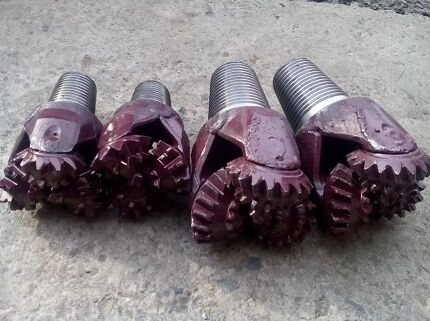
The drilling rig can be mounted on high-capacity vehicle vehicles or on tracked vehicles special equipment in case of work in difficult terrain conditions. Lighter mobile equipment can be used when drilling water wells using the core method.
Advantages and disadvantages of the core method
Thanks to the point action of the crown along its radius, accurate cutting and bringing to the surface of a solid core is ensured. The technology is applicable for drilling rocks up to XII categories, you can work both perpendicularly and at an angle.
One of the most important indicators of the core method is high productivity and drilling speed.
In addition to this, the following advantages can be highlighted:
- The drilling volume in the case of using flushing fluid or process water is 85%;
- The introduction of active emulsions into the working solution makes it possible to maintain the well walls in their original state;
- Due to the reduction in axial loads due to the fact that the rock is not destroyed in a continuous manner, a reduction in energy costs is achieved.
- The method allows you to work with any rocks, including basalt and granite.
- When using a prefabricated mobile machine, it is possible to carry out work in hard-to-reach places.
Along with its advantages, core drilling also has its disadvantages:
- When working in fractured rocks, core jamming often occurs, which leads to the need to remove the pipe to knock it out.
- When passing through hard rocks, the bit quickly becomes dull due to overheating and sticking. To avoid this, it is necessary to use coolant and reduce the flow rate. As a result, the drilling speed decreases.
- The small cross-section (up to 200 mm) of drilling does not allow the use of powerful submersible pumps.
When developing water wells, if a clay solution is used when opening the formation, there is a high probability of siltation of the aquifer.
Conclusions and useful video on the topic
Video 1. The initial stage of drilling a well using the core method:
Video 2. Core drilling of a well in granite rock:
The start of core drilling of a well must be preceded by an economic calculation. Compliance with safety standards and operating rules for equipment minimizes the risk of equipment failure, thereby ensuring high operating efficiency, drilling speed and reduced economic costs.
Would you like to share the intricacies of column technology known only to you? Do you have useful information on the topic of the article? Please write comments in the block form below, ask questions and post photos on the topic of the article.



